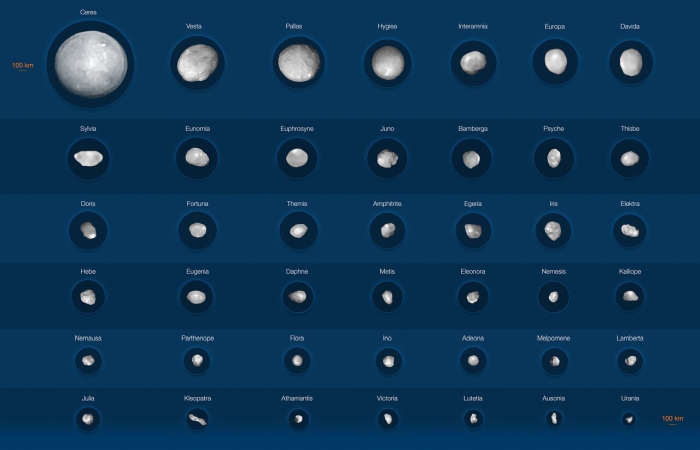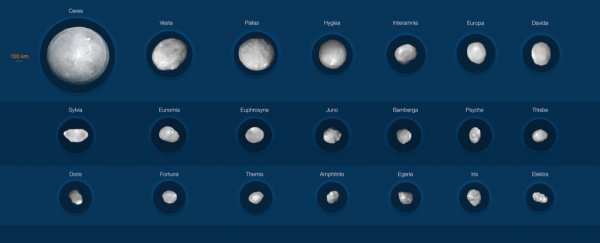If there's one thing our Solar System doesn't have in short supply, it's rocks.
Small rocks, chunky rocks, dry rocks, icy rocks. Rocks that are like other rocks. It's the rocks' system, really – we just happen to live here too. For all their prevalence, though, these rocks aren't easy to see; they're small, and dim, and outshone by bigger, brighter objects.
But we're getting better at it, and now we've gotten the most detailed look yet at some of the biggest rocks in the Solar System that aren't planets. An international team of astronomers has used the European Southern Observatory's Very Large Telescope to image 42 of the largest objects that hang out in the asteroid belt between Mars and Jupiter.
"Only three large main belt asteroids, Ceres, Vesta and Lutetia, have been imaged with a high level of detail so far, as they were visited by the space missions Dawn and Rosetta of NASA and the European Space Agency, respectively," said astronomer Pierre Vernazza of the Laboratoire d'Astrophysique de Marseille in France.
"Our ESO observations have provided sharp images for many more targets, 42 in total."
 The 42 asteroids. Click here to view the full-size image. (ESO/M. Kornmesser/Vernazza et al./MISTRAL algorithm/ONERA/CNRS)
The 42 asteroids. Click here to view the full-size image. (ESO/M. Kornmesser/Vernazza et al./MISTRAL algorithm/ONERA/CNRS)
We've already had a sneak preview of the images. Last month, researchers revealed the best images to date of a peculiar, dog-bone-shaped asteroid named Kleopatra. The data revealed that Kleopatra's two moons may have formed from dust ejected by the asteroid itself.
The new work is much more sweeping, designed to examine the collective properties of these objects, rather than their individual characteristics, with new 3D data that help to reveal the shape and mass of these mysterious asteroids. Broadly, the objects fall into two categories: those that are nearly round; and those that are more elongated, with Kleopatra being the most extreme example of the latter.
Interestingly, these categories are not divided along size lines. Ceres, the largest object probed in the survey with a diameter of 940 kilometers (584 miles), is pretty round. Vesta, the second-largest at 520 kilometers, has a more uneven shape. Flora and Adeona, at 146 and 144 kilometers respectively, are also pretty round. Sylvia, at 274 kilometers, is elongated.
The new 3D data gave the researchers much better constraints on the volumes of the 42 objects, too. Once you know the volume and the mass of an object, you can calculate its density, and infer its composition. Once again, there was a wide range in the sample.
Earth's density, for context, is 5.51 grams per cubic centimeter. The least dense asteroids had densities around 1.3 grams per cubic centimeter, around the same density as coal, suggesting a carbonaceous, porous composition. The most dense were Psyche and Kalliope, with densities of 3.9 and 4.4 grams per cubic centimeter respectively, which is more dense than diamond, suggesting a stony-iron composition.
 A poster of the 42 asteroids and their orbits. Click here to view the full-size image. ESO/M. Kornmesser/Vernazza et al./MISTRAL algorithm/ONERA/CNRS)
A poster of the 42 asteroids and their orbits. Click here to view the full-size image. ESO/M. Kornmesser/Vernazza et al./MISTRAL algorithm/ONERA/CNRS)
This suggests that the objects in the asteroid belt likely came from different regions of the Solar System before ending up where they are now, the researchers said.
"Our observations provide strong support for substantial migration of these bodies since their formation," said astronomer Josef Hanuš of Charles University in Czechia.
"In short, such tremendous variety in their composition can only be understood if the bodies originated across distinct regions in the Solar System."
There's a lot we still don't know, though. We have asteroid samples here on Earth, fragments that have broken apart and ended up here as meteorites, which allows us to make certain inferences about space rock compositions. Some of the higher-density objects, however, may not have analogs available, which makes ascertaining their composition more tricky.
In addition, we can't currently see smaller asteroids in detail, which means we are operating with an incomplete set of data. Once we have this information, we will be able to better assess which asteroids we should send future space probes to visit. For this, the team has their hopes pinned on the upcoming Extremely Large Telescope, due to commence operations within a few years.
"ELT observations of main-belt asteroids will allow us to study objects with diameters down to 35 to 80 kilometers, depending on their location in the belt, and craters down to approximately 10 to 25 kilometers in size," Vernazza said.
"Having a SPHERE-like instrument at the ELT would even allow us to image a similar sample of objects in the distant Kuiper Belt. This means we'll be able to characterize the geological history of a much larger sample of small bodies from the ground."
Rock 'n' roll.
The research has been published in Astronomy & Astrophysics.
